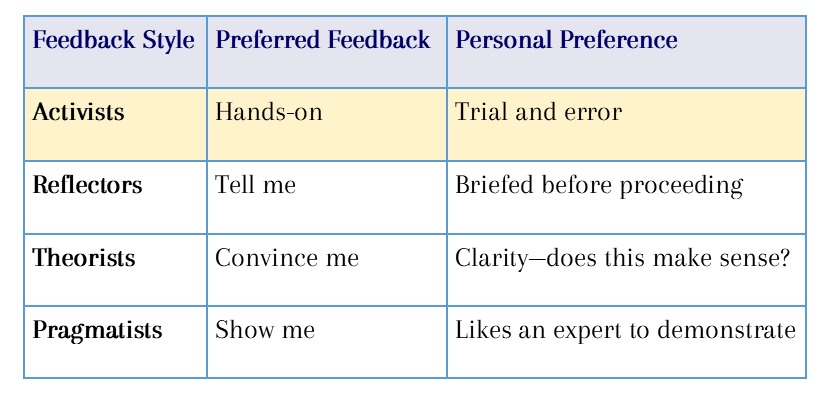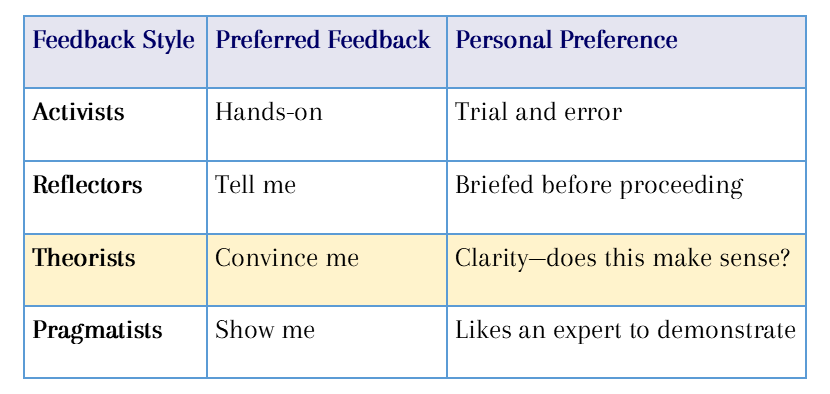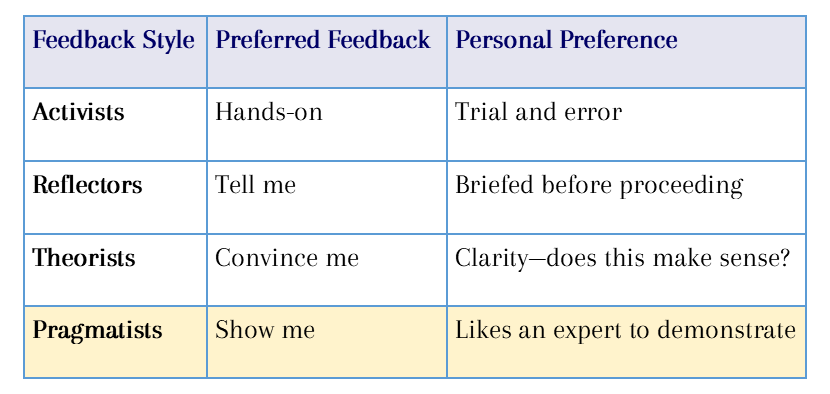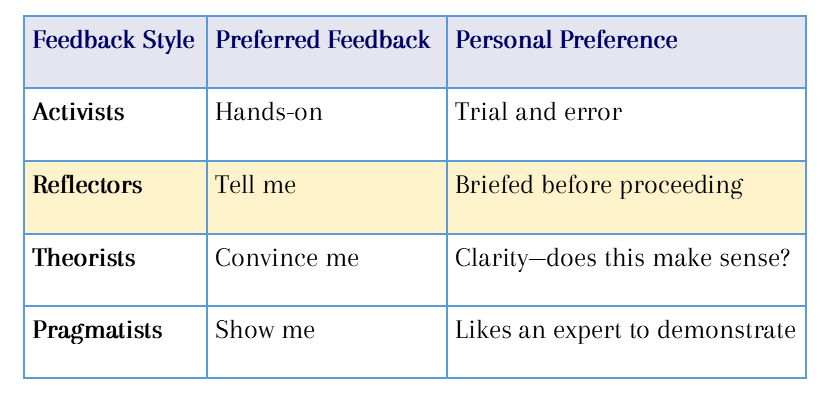
“We all need people who will give us feedback.
That’s how we improve.”
Bill Gates
Feedback Styles:
When we give and receive feedback, we each have our own preferred styles and filters.
While there is no catagoric right or wrong way to communicate, understanding our tendency to be more focused in one area and not as focused in another – especially if we are communicating with someone who has the direct opposites as their natural tendency – helps us to better give and receive feedback, to respect the differences between us as well as the commonalities, and to assist each other to rise from good to great.
Activist
Activist Activist prefer to learn by doing. They need hands-on activities to learn. Activists plug things in before even reading the quick start guide. An activist will only read a manual as a last resort. Activists have an open-minded approach to new experiences and are quick to fully engage in new learning activities. When communicating to activists incorporate:
When writing and formatting learning materials for activists consider adding:
Careers to which strong activists may be especially drawn include:
“Activists involve themselves fully and without bias in new experiences. They enjoy the here and now, and are happy to be dominated by immediate experiences. They are open-minded, not skeptical, and this tends to make them enthusiastic about anything new. Their philosophy is: “I’ll try anything once”. They tend to act first and consider the consequences afterwards. Their days are filled with activity. They tackle problems by brainstorming. As soon as the excitement from one activity has died down they are busy looking for the next. They tend to thrive on the challenge of new experiences but are bored with implementation and longer term consolidation. They are gregarious people constantly involving themselves with others but, in doing so, they seek to center all activities around themselves.” – Honey and Mumford |
Theorist
Theorist Theorists prefer to learn by understanding the fundamental principles of the subject. They need models, concepts, and facts when learning. They prefer to analyze and synthesize, drawing new information into a systematic and logical ‘theory’. When communicating to theorists incorporate:
When writing and formatting learning materials for theorists consider adding:
Careers to which strong theorists may be especially drawn include:
“Theorists adapt and integrate observations into complex but logically sound theories. They think problems through in a vertical, step-by-step logical way. They assimilate disparate facts into coherent theories. They tend to be perfectionists who won’t rest easy until things are tidy and fit into a rational scheme. They like to analyze and synthesize. They are keen on basic assumptions, principles, theories models and systems thinking. Their philosophy prizes rationality and logic. “If its logical its good.” Questions they frequently ask are: “Does it make sense?” “How does this fit with that?” “What are the basic assumptions?” They tend to be detached, analytical and dedicated to rational objectivity rather than anything subjective or ambiguous. Their approach to problems is consistently logical. This is their ‘mental set’ and they rigidly reject anything that doesn’t fit with it. They prefer to maximize certainty and feel uncomfortable with subjective judgements, lateral thinking and anything flippant.” – Honey and Mumford |
Pragmatist
Pragmatist Pragmatists prefer to learn by understanding how they can directly implement or apply an idea. They need to know the specific steps required to put new ideas into practice in order to learn. This may include how to set up the experiment and evaluate the results. Abstract concepts, models, and games are of limited use to pragmatists. The need to see the specific next steps to take. They like trying out as experiments new ideas, theories, and techniques to see if they work. When communicating to activists incorporate:
When writing and formatting learning materials for pragmatists consider adding:
Careers to which strong pragmatists may be especially drawn include:
“Pragmatists are keen on trying out ideas, theories and techniques to see if they work in practice. They positively search out new ideas and take the first opportunity to experiment with applications. They are the sort of people who return from courses brimming with new ideas that they want to try out in practice. They like to get on with things and act quickly and confidently on ideas that attract them. They tend to be impatient with ruminating and open-ended discussions. They are essentially practical, down to earth people who like making practical decisions and solving problems. They respond to problems and opportunities ‘as a challenge’. Their philosophy is There is always a better way and If it works it’s good.” – Honey and Mumford |
Reflector
Reflector Reflectors prefer to learn by observing and thinking about what happened. They may avoid leaping in and participating during a large class, or asking and answering questions in a group, as they prefer to watch from the sidelines. Reflectors prefer to stand back and view experiences from a number of different perspectives, collecting data, and taking the time to work towards an appropriate conclusion. When communicating to reflectors incorporate:
When writing and formatting learning materials for reflectors consider adding:
Careers to which strong reflectors may be especially drawn include:
“Reflectors like to stand back to ponder experiences and observe them from many different perspectives. They collect data, both first hand and from others, and prefer to think about it thoroughly before coming to a conclusion. The thorough collection and analysis of data about experiences and events is what counts so they tend to postpone reaching definitive conclusions for as long as possible. Their philosophy is to be cautious. They are thoughtful people who like to consider all possible angles and implications before making a move. They prefer to take a back seat in meetings and discussions. They enjoy observing other people in action. They listen to others and get the drift of the discussion before making their own points. They tend to adopt a low profile and have a slightly distant, tolerant unruffled air about them. When they act it is part of a wide picture which includes the past as well as the present and others’ observations as well as their own.” – Honey and Mumford
|




